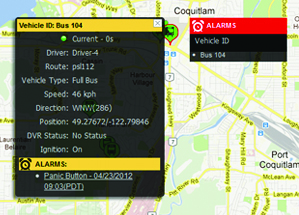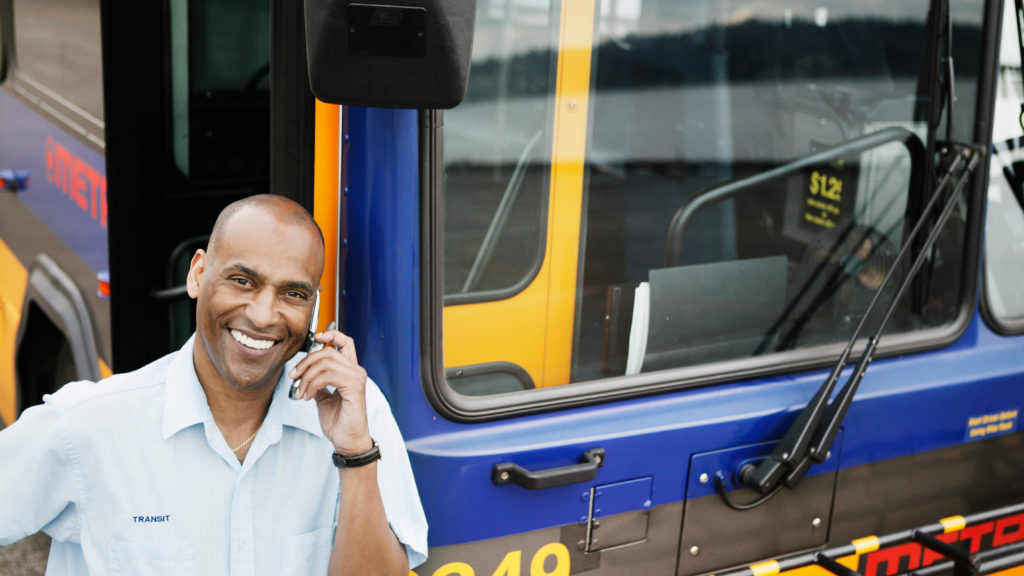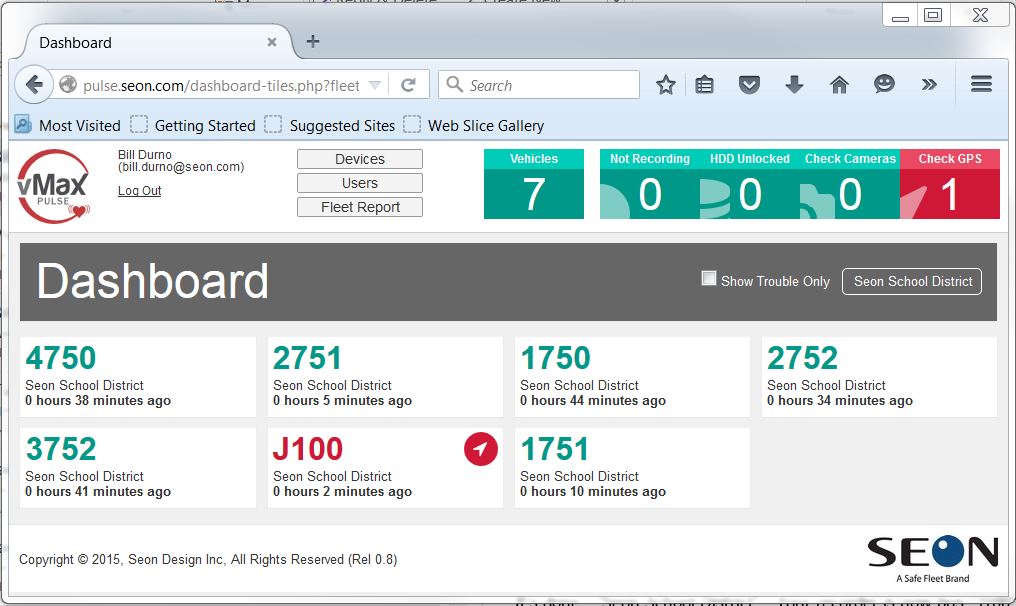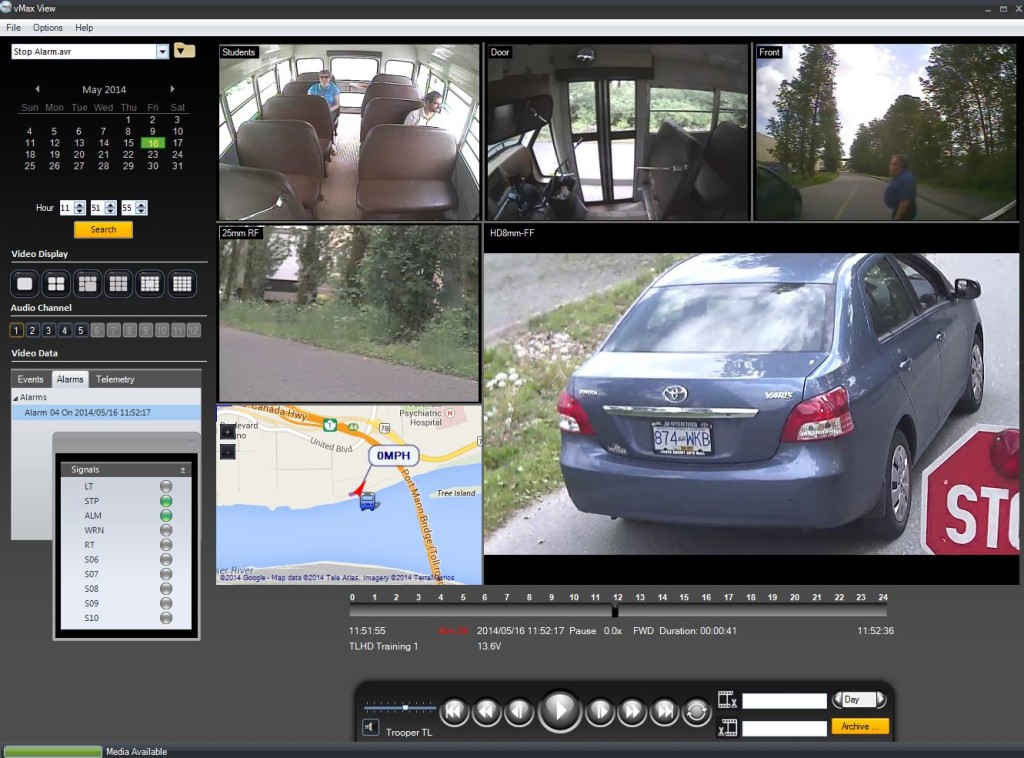We would like to share expert insights and best practices that will help you increase safety and security of your passengers and operators, keep your fleet operations under control, and reduce costs of on board incident investigations.
-
- The Importance of a Proactive Approach to Transit Safety
- Reducing the Risk of Operator Assaults
- Calculating The ROI of Transit Surveillance
- The Key to Video Surveillance Implementation Success
- Preparing for Emergencies: The Latest in Surveillance Technology
- Operator Assault Prevention: Training and Best Practices
- Hybrid DVRs: Preserving your Security Investment
- Enhancing Driver Visibility – Removing the Deadly Blind Spot
- Practical Tips For Better Video Management
- Video Surveillance Footage Review – Best Practices
The importance of a proactive approach to transit safety
A transit operator once told me: “When people board our buses they come with different expectations for the quality of our service, but everyone expects their ride to be safe.” So how do agencies make sure they are delivering on that most basic of expectations? The answer: a proactive approach to transit safety.
Anticipate, assess, and prioritize
Being proactive means first dedicating the time and resources to anticipate common safety issues and to accurately assess needs and risks. Although this may seem time-consuming, a little up-front planning can identify areas of concern and help minimize, or even avoid, future risk. On the flip side, being reactive and waiting for an incident to occur may mean that agencies don’t actually have the tools or resources to efficiently resolve or address it. This can lead to longer resolution times, customer and employee dissatisfaction, and greater long-term costs.
Make a list of all foreseeable safety risks and then determine their frequency and cost to the organization. Costs might include labor involved in investigating an issue, repair costs, legal costs or lost work hours. This will help an agency assign a relative priority to determine where to focus its efforts. Agencies may list vandalism, on-board crime and operator assaults as top issues, but the frequency of operator attacks may have risen recently and resulted in union grievances, lawsuits and lost work hours. The increase in frequency and cost makes it the highest priority.
The recipe for a proactive approach to transit safety
The perfect recipe for a proactive approach to transit safety requires three essential ingredients: policies, education and technology. Blended together, they result in a comprehensive security plan. It’s essential to not miss any key ingredient for the best possible result.
Agencies may not always be able to prevent security situations, but by preparing for these issues in advance (using these three key ingredients), they can respond to them more quickly and avoid a prolonged and expensive investigation.
Developing the right policies
Policies might include a code of conduct to address safety issues and guide passenger-driver interactions, or a fare collection policy that minimizes the risk of operator assault. Doug Mosher, Halifax Metro’s manager of transit security, recommends operators act as Fare Informers, instead of Fare Enforcers, as a way to ensure that conflicts over fare payment don’t lead to operator assaults.
Training staff
Operator training is important in the prevention of operator assaults. Conflict resolution and de-escalation techniques can be especially useful to defuse emotionally charged situations so that assaults are prevented. Bill Parsons, personal safety expert at Roadworthy Communications, recommends a comprehensive communication, safety and customer service program rolled into one. This type of program gives operators an effective set of tools to mitigate and manage conflict by influencing the decisions that riders make in subtle but noticeable ways.
Using technology
Technology also plays an important part in preventing, responding to, and investigating operator assaults. Having operators point to the surveillance cameras and remind unruly passengers that they are being recorded, can actually help prevent an operator attack. When an assault is happening, a driver-triggered panic alarm in conjunction with live vehicle tracking can alert security staff, help them quickly locate the vehicle, and dispatch emergency services and engage law enforcement. Security staff can even tap into installed bus cameras to monitor the situation using live video streaming.
By proactively installing the right on-board technologies, agencies can also significantly reduce the cost of assault investigations by reducing the labor involved in the investigation and mitigating any legal repercussions. Recorded video of an assault can provide clear, indisputable evidence of the events leading up to the attack and can help apprehend and prosecute the perpetrator.
Operator assault is just one important transit safety issue that can be addressed with a proactive approach. Take a moment to consider your pressing safety issues, whether you are being proactive or reactive, and what blend of policy, education and technology will ensure you meet customer expectations.
Customer Success Story: Find out how video surveillance helped BC Transit increase driver and passenger safety and reduce liability and investigation costs in our Case Study.
5 Ways to Reduce the Risk of Operator Assaults
Daily news headlines tell a horrifying tale of drivers being slapped, punched, kicked and even stabbed while trying to complete their daily routes. The nature of their job, working alone, with the public, collecting money in a small confined space, puts them at risk.
Operator assaults have increased by 31 percent over the last six years according to the National Transit Database (NTD). These assaults can have a lasting financial impact on the transit system.
Lost work hours, absenteeism, worker’s compensation claims, and lawsuits are just the beginning, and can lead to loss of public confidence in the safety of the transit system, decreased ridership, and ultimately reduced fare box collections.
To mitigate these significant risks, there are five things every transit agency should be doing to reduce the risk of operator assault:
- Conflict de-escalation training
- On-board security technology
- Launching a public awareness campaign
- Lobbying for tougher penalties
- Tracking operator assaults
1. Conflict de-escalation training
Many assaults on bus operators are related to fare disputes or enforcement of bus rules. They often start as a verbal exchange which can quickly turn into a violent attack. Many of these assaults can easily be prevented by incorporating conflict de-escalation techniques in regular customer service training for bus operators.
Bill Parsons of Roadworthy Communications recommends a comprehensive communication, safety and customer service program all rolled into one. This type of program gives the operator an effective set of tools and techniques to mitigate conflict and manage it when it arises, by influencing the decisions that riders make in very subtle but noticeable ways.
2. On-board security technology
Video surveillance is considered one of the most effective ways to protect operators from assaults according to a survey conducted by the Transportation Research Board and summarized in TCRP Synthesis 93. Simply pointing out the presence of video cameras and signage warning passengers they may be recorded has helped countless bus operators to prevent conflict from escalating into violence.
As a leading provider of video surveillance technology, Seon has seen results of a combination of video and audio surveillance and a driver panic alarm. When an assault is anticipated, the driver presses a panic alarm to mark the surveillance footage for future review, or if the bus is equipped with real-time transmission technology, the alarm can alert transit security who can tap into the installed bus cameras to monitor the situation in real-time. Having a camera placed over the driver’s shoulder pointing at the stepwell of the front entrance of the bus will capture fare box interaction and help identify assailants, while a camera placed by the front door pointing at the driver will capture the entire driver-passenger interaction leading up to an assault.
3. Launching a public awareness campaign
Capturing an assault on video is just the first step in reducing the future risk of assault for other operators. The public needs to receive the message that all assaults on operators will be prosecuted to the full extent of the law. Key to a public awareness strategy is publicizing key arrests and penalties received for operator assaults to discourage future transgressions. Many transit agencies have also seen success by launching public awareness campaigns to inform the public of appropriate bus behavior and the penalties for assault against a bus operator
4. Lobbying for tougher penalties
Essential to the public message against operator assaults is an adequate penalty for the offense. The Canadian Urban Transit Association (CUTA) saw recent success of its lobbying efforts for tougher penalties for bus operator assaults with the introduction of Bill-221 into law this past March. The bill amends the criminal code to require a court to consider the fact that, if the victim of an assault is a public transit operator, it must be considered an aggravating circumstance for the purposes of sentencing by a judge. The new law is supported by a new advertising campaign for bus stops across Canada to help spread the message that assaults against operators could land perpetrators in jail.
5. Tracking operator assaults
Every agency should have a procedure and system in place to report assaults and track their frequency. This data is important in justifying security upgrades and demonstrating the effectiveness of any initiatives to reduce assaults. Without a benchmark, any improvements or worsening of the situation can’t be measured.
Need a Strategy Check-up?
Watch our video for tips on successful strategies for bus driver protection.
Calculating The ROI of Transit Surveillance: A Step-by-Step Guide
Passenger & driver safety and security is at the core of every successful transit system operation. But when it comes time to cough up the money to upgrade camera equipment or add more camera views, it can often be difficult to secure funding. Many transit agencies find the need to justify their camera purchase with the powers that be. What many have found most useful is a return on investment (ROI) calculation that shows exactly what improvements and cost reductions can be achieved through investment in the latest security technology.
To justify your next transit security upgrade, we thought we’d share our step-by-step guide to calculating the ROI of transit surveillance.
Here are some of the steps we suggest you take to justify your next bus camera system purchase:
Step 1: Identify Your Problem Areas
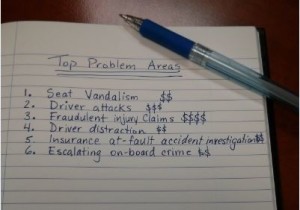
One of the best places to start is by making a list of your problem areas, or in other words the biggest drains on your time and finances. For a lot of agencies this is fraudulent injury or accident claims. For others it might be vandalism such as graffiti or seat destruction, increasing crime rates, or driver assaults. Try to put together as comprehensive a list as possible, it may surprise you how a few small things can add up to make a big impact.
Step 2: Collect Data

The next step is to take the list you just created and collect the data required to establish your current costs, in order to create a baseline. It holds way more credibility if you use actual data (i.e. number of events or expenses and the average cost based on data from the past 3 years). For example, one transit agency we worked with had a significant amount of fraudulent claims and collected data on the number of claims per month, the average dollars paid out, the number of claims that went to litigation, and the amount of resources required to investigate claims. These numbers formed the basis of their ROI calculation.
Consult your risk management, legal, or human resources departments to collect this data. It helps to calculate the monthly costs in order to establish your payback period. You can be as detailed or as general as your agency allows or time permits.
Step 3: Set Goals & Objectives

Once you have collected your data, the next step is to set some realistic and feasible goals and outcomes from your purchase. Take the same data that you collected in step two and determine which of these costs can be reduced or eliminated with your camera system purchase.
Some of the most common goals are to reduce the number of fraudulent injury claims, reduce the hours required to investigate claims, reduce vandalism, and reduce absenteeism and medical costs from driver assaults.
From the ROI calculations we have been involved in it is not unexpected to see the number of fraudulent claims reduced by between 30 and 50% and the amount of time required to investigate those claims reduced from several days to under an hour.
Step 4: Do the Math
 Now that you have determined what factors will have an impact on security costs, collected historical data, and made some projections on what costs you can reduce or eliminate, it’s time to do the math.
Now that you have determined what factors will have an impact on security costs, collected historical data, and made some projections on what costs you can reduce or eliminate, it’s time to do the math.
First, tally up the costs before installing cameras and then subtract your projected costs after the cameras are installed to calculate your savings per month. Then, use the calculation below to determine your payback period:

Based on the calculations we’ve participated in with clients, this payback period typically ranges from 12 to 24 months.
The next step is to take those numbers and calculate your ROI over the optimal operating period of a typical camera system, for example 5 years. Here is a sample calculation from one transit agency with 300 buses:
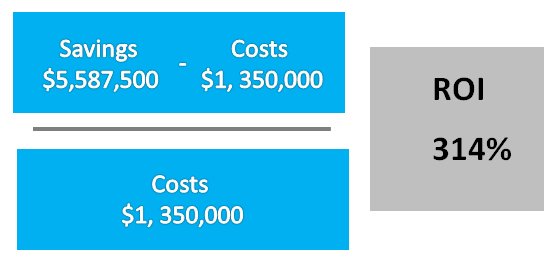
Following these 4 simple steps to calculate the ROI of transit security should help you justify your camera purchase and convince your decision committee that investing in improvements to transit security can actually yield a positive return on investment.
The Key to Video Surveillance Implementation Success
Video surveillance technology can be an important tool to address security and liability issues on public transit, but an equipment purchase alone is not enough to ensure success. Once a transit agency has calculated the ROI of their surveillance upgrade and secured funding, the real work begins. We’ll use a real-life customer scenario in the state of North Carolina to illustrate some key factors that contribute to a successful video system implementation.
Establish Clear Objectives
Having clear goals and objectives is the first step in any technology implementation project, and it is no different for video security upgrades. Start with a project charter that specifies what problems the technology will address, and quantifies the expected improvements and the time-frame those improvements are expected. This will both keep the project on track and in scope, and can be used to assess your success post-implementation.
For the North Carolina Department of Transportation (NCDOT), the goal was to equip 1500 para-transit and demand response vehicles in 83 counties with video surveillance technology from a single supplier within a 12 month period. The key objectives for the technology were: reducing accident re-construction costs, improving driver behavior, and streamlining the incident investigation process.
Build the Right Team
Assembling the right team, and ensuring that all key stakeholders and influencers are consulted, is another key element. NCDOT used a multi-pronged approach. First, they secured key executive sponsorship for the project, to display a top-level show of support and demonstrate the project’s top priority. Second, they consulted every key stakeholder that would either be involved in the implementation, or would be impacted by the new technology on an on-going basis, to ensure they were committed to its success. Finally, they chose tech-savvy people to add to the project team that understood the technology and its benefits, to drive the project forward.
Do Your Research
Once the project team is in place, do your research so that you select a technology and a vendor that will support your objectives. Technology should suit your current needs, plus accommodate any future requirements or initiatives, without a full-scale replacement.
Choosing the right vendor is critical. Consider not just price and functionality, but experience with projects of similar size and scope, reputation for reliability and support, and overall responsiveness. NCDOT did extensive research on their technology options, discussed their needs with multiple vendors, and then tested five short-listed vendors to ensure their systems met claims of reliability, ease-of-use, and functionality.
Plan for Success
Have a detailed plan, not only for implementation, but also for post-installation and on-going maintenance. Assign roles to responsible teams. Develop a technology refresh program, to make sure the equipment is replaced in a timely fashion. Also consider the following:
- How will you retrieve video recorded on the bus, and then ensure the chain of custody for that footage?
- What is the process required to request video footage?
- How will you restrict access to video and ensure driver and passenger privacy.
Put all of these decisions into a formal video surveillance policy, vet it with your legal team and publish it. NCDOT researched and created a template document that made it easy for all participating transit agencies to modify and adopt.
Spread the Word
Once your new surveillance system is installed, it is important to let drivers, passengers, and the general public know about your security upgrade. Show drivers how the new technology can protect them, and how they can use the presence of that technology to diffuse conflict. Make sure that you address any concerns with the driver’s union up front and secure their help in making drivers comfortable with the change. For NCDOT, it was important for drivers to see how the camera footage could help them improve their customer service levels, and prevent or address on-board incidents.
Consider a public awareness campaign to make the travelling public aware of the change in security. This can be as simple as posting a notice at the entry of the bus, or as sophisticated as a multi-media campaign to inform customers of the added protection measures. Studies have shown that public awareness that the cameras exist can actually reduce the number of incidents that occur.
Measure Your Success
After your security upgrade is complete, don’t forget to look back at your initial objectives to ensure you’ve attained the goals of the project. If there are shortfalls, determine why and develop a plan to address them. By following the key success factors above, NCDOT was able to get 95% adoption of the technology in just over twelve months, prove 75% of injury claims were false, and reduce insurance costs and payouts. In addition, video proved to be a great tool for driver coaching and helped reduce accident investigation times significantly.
Preparing for Emergencies: The Latest in Surveillance Technology
In an emergency situation, every second counts. To prepare for the unthinkable, you not only need to train operators and conduct drills, but implement the right tools and technologies in advance. Here are few suggestions to give transit security staff better on-board visibility to assess and respond to emergencies quickly and improve incident investigations.
Add more cameras for a better view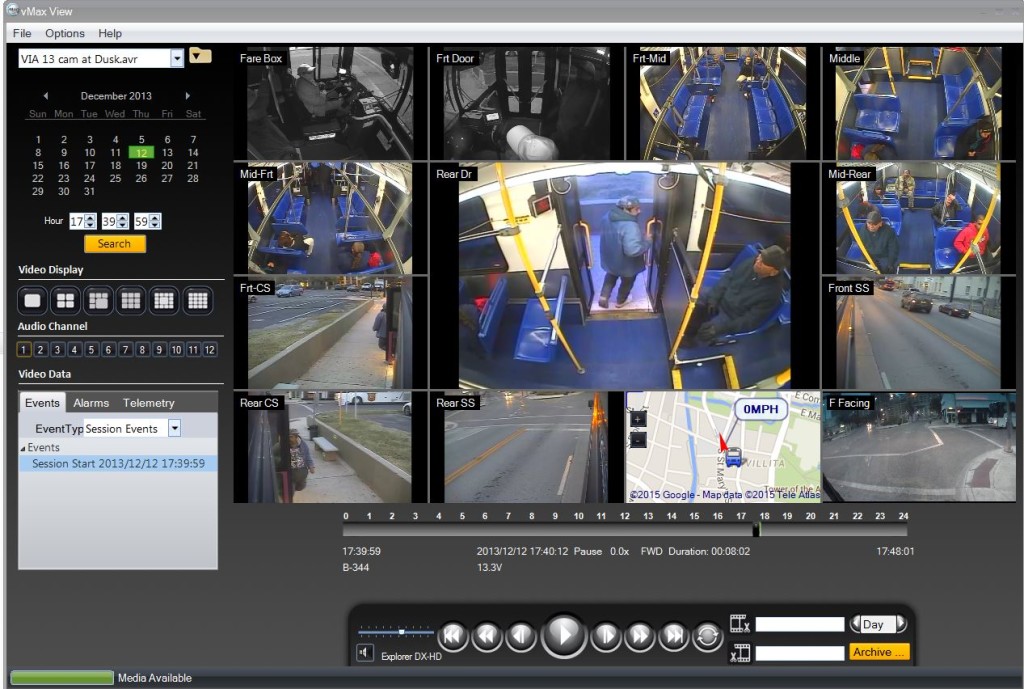
You never get a second chance to get a better view. Camera placement is critical to delivering the right footage no matter where an incident happens on and around the bus. While there is a trend towards high-resolution cameras to improve views outside the bus (i.e. capture license plates), ensure you have enough cameras to prevent any gaps in visibility inside the bus, especially in high incident-prone areas, such as the bus entrance, driver seat, and fare box area.
Alarm-triggered recording and live alerts
Give drivers the tools to alert security staff to an on-board emergency and trigger recording of the incident. A panic button connected to the on-board surveillance system can trigger recording of a special camera view of the driver in case of assault, if union agreements prevent you from continuously recording drivers. It can also transmit a live security alert via email or on-screen in a real-time vehicle tracking application such as Seon’s vMax Live Plus.
Live streaming video
One of the newest and most effective technologies for assessing emergency situations as they happen is live streaming video. This technology allows authorized transit staff tap into secure footage from any installed bus camera in real-time, to access live video and audio as the emergency unfolds. This technology is particularly useful in hostage situations or where a driver is unreachable via radio due to a medical condition.
Integrated vehicle tracking
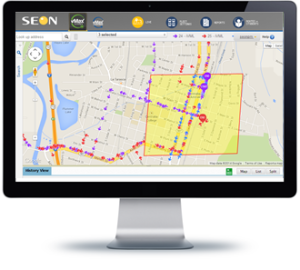 A live fleet tracking application can tie all of this technology together in a single map-based view. Your emergency response team can view live on-screen alerts when panic buttons are pressed, locate the exact GPS location of the bus to dispatch help to the scene, and even click on the bus to tap into live on-board video to assess the situation.
A live fleet tracking application can tie all of this technology together in a single map-based view. Your emergency response team can view live on-screen alerts when panic buttons are pressed, locate the exact GPS location of the bus to dispatch help to the scene, and even click on the bus to tap into live on-board video to assess the situation.
Locate the right footage and auto-download
With video management software and a wireless network in your bus depot, you can download alarmed video footage automatically as the bus returns to the yard. Or when an incident occurs you can schedule a download from any device via a web-based application. Video management software also makes it easier to locate video related to a crime scene. Simply highlight the incident location on a map to display all vehicle tracks travelling through the area and click the vehicle track to set a start and end point for your download.
When disaster strikes on a transit vehicle, transit agencies are under intense public scrutiny. Could the incident have been prevented? Did they do everything they could to respond quickly and efficiently? What really happened and who is at fault? Having the right evidence at your fingertips can mean the difference between a prolonged civil suit costing millions, and a speedy investigation absolving you of wrongdoing. In this case, it pays to be prepared in advance.
Using Video for Accident Investigation?
Download our Summaryof the National Transportation Safety Board (NSTB) report highlighting the importance of installing continuous video systems for accident re-construction.
Operator Assault Prevention: Training and Best Practices
We started this series by talking about the importance of taking a proactive approach to transit safety with three key ingredients: policies, education and technology. This recipe for success applies to operator assault prevention. We have explored a number of technologies that help address operator assaults, such as on-board video systems, panic alert buttons and live vehicle tracking, but the best way to protect bus drivers is to train them to prevent conflicts, put in place supportive policies and create public awareness campaigns.
Positive attitude for conflict prevention
Bill Parsons, a recognized expert and trainer in personal safety, feels that a key component of assault prevention training is getting drivers to choose a positive mindset and attitude toward service to others. This way of thinking influences how operators are perceived and treated.
A colleague of mine had a perfect example of a bus driver using a positive attitude for conflict prevention on a recent ride home from work. She was traveling on a bus full of primarily business commuters when a loud, intoxicated group of people boarded at the next stop. As the ride progressed, passengers were becoming increasingly uncomfortable by the group’s use of foul language and the volume of their voices. At that point the driver decided to jump in and improvise.
Instead of arguing or lecturing, the driver greeted everyone on board, introduced himself and said that when it is raining it was usually challenging to navigate the bus. Since it was pouring rain outside, he apologized for the slower traffic on the roads. Then he added, “But today, you should enjoy your trip even more since we have a very special drive with both stormy showers, and ‘stormy’ passengers.” Everyone on the bus laughed, and the noisy revelers quieted down. This was a great illustration of how humor and a positive mindset helped to prevent a confrontation that may have led to violence.
Explore communications strategies
Operator training should help drivers to understand that the way they communicate impacts not only their own personal safety, but job satisfaction, customer service and organizational perception.
Teaching drivers to choose the right tone of voice and use their words carefully can help them avoid conflict that may result in violence.
Video surveillance footage can be useful to correct deteriorating driver communication habits. When investigating a passenger complaint that a driver was rude or provoked the situation, pull the video footage, view it with the driver and their union representative when applicable, and use it for a positive coaching experience. If the driver used the right words and tone, compliment them and share the good deed with others. If the driver was rude, they often will recognize this during the viewing. Ask them how they could have handled the situation differently and work together on choosing a more positive approach. Seeing themselves on video is often a catalyst to better self-awareness and future customer interaction.
Policies for conflict avoidance
A great way to help drivers avoid conflict is to develop policies that support rather than put operators in harm’s way. Disputes about fare collection are one of the most common examples of driver-passenger conflict. Halifax Transit’s fare collection policy allows operators to be Fare Informers, not Fare Enforcers.
Many transit agencies also have a ridership code of conduct that they post at the entrance of every bus. Drivers can avoid conflict by pointing to the guidelines when confronted with a difficult situation
Campaigns to curb driver abuse
Putting the right policies in place and training drivers are effective means of avoiding conflict that leads to assaults, but the actions of passengers are often not within your control. That’s where the success of public awareness campaigns can help. The Amalgamated Transit Union (ATU) Local 583 that represents Calgary Transit operators recently revealed a campaign to help stop driver abuse. Their ‘Be an Easy Rider’ campaign featured posters aboard problematic routes, transit shelters and billboards, encouraging transit riders to “be good to your driver and enjoy the ride.”
According to an ATU publication, “Preventing Violence Against Bus Operators: A Fact Sheet for Local Unions”: “A media campaign aimed at enlisting the support of the public can reduce assaults and increase respect for operators. Successful media campaigns address passenger safety concerns as well as driver protection.” Operator assault is one of the biggest risks to passenger safety and organizational liability. Having the right tools and training in place to mitigate that risk and prevent assaults from happening in the first place should be something every transit agency puts into practice
Prevent Conflict on the Bus: A Visual Guide for Operators
Download our infographic to help drivers avoid or solve conflicts
Hybrid DVRs: Preserving your Security Investment
Keeping up with the latest technology is hard. New mobile security products are being developed every year with more bells and whistles. It seems the only constant is change. So how does a transit agency ensure that their mobile surveillance system is up to date while keeping budgets in check? One cost-effective solution to consider is a hybrid digital video recorder (DVR).
What is a Hybrid DVR?
Similar to a hybrid vehicle that uses two forms of energy (gasoline & electric), a hybrid DVR can record video and data from two types of video security cameras – traditional analog and digital high-definition (HD) or ‘IP’ cameras. Traditional analog cameras are most common in mobile surveillance and still made up almost 95% of new camera sales in 2015 (Source: IHS Group). Hybrid DVRs give you the flexibility to add new high-definition cameras where it makes sense while preserving your initial analog camera investment.
An example of a Hybrid DVR is Seon’s new Explorer model HX16, a sixteen channel DVR designed for mobile applications. HX16 DVRs support connection of up to 12 analog cameras and up to 4 HD (IP) cameras.
A Brief History
So what is the difference between traditional analog and IP cameras? Analog cameras go way back to the days of VHS tape recorders, when operators were required to search through hours of video evidence to find video of interest. But analog cameras continued in popularity even after the introduction of digital video recorders in the late 90’s.
Even with the adoption of DVR technology, high-definition, ‘IP’ cameras really have only emerged in the mobile surveillance market in the last three years. One of reasons for this is due to gradual improvements in analog camera technology in terms of camera size, lens options, reliability, digital signal processing and more lines of resolution. According to the 2015 IHS Report on Mobile Surveillance, in some cases there is an overlap in resolution and image quality of high-end analog cameras and low-end IP cameras.
Another reason for the continued popularity of analog cameras is video storage and retention. Although high-definition cameras can produce an image 3 to 6 times the resolution of an analog camera, they also consume 3 times more storage space, thereby reducing the number of days of video you can store on the hard drive before being overwritten.
What are the Benefits of a Hybrid?
Beyond the simple connection of two camera technologies, hybrid DVRs have a number of advantages for transit agencies looking to upgrade their security systems. The obvious benefit is cost. Replacing an entire surveillance system with a DVR, up to 16 cameras, wireless technology, playback and video management software can be expensive. Hybrid DVRs allow you to improve your return on investment and extending the useful life of your analog cameras and software. You can focus your budget dollars on adding more cameras to provide more coverage in and around the bus, rather than replacing existing cameras.
Being able to continue to record video and audio from analog cameras also reduces the DVR storage requirements, allowing you to store more hours of video on the DVR hard drive before needing to download.
Once you’ve installed a Hybrid DVR you can gradually introduce high-definition cameras in specific areas of the bus where a higher resolution image is required for incident review, such as the fare box, windshield, or exterior of the bus. You have a wider range of camera selections to choose from to suit your application. You will have a higher quality picture and the ability to zoom-in on images to create better video evidence essential in license plate capture.
When does a Hybrid DVR make sense?
The main reason for purchasing a hybrid DVR is to introduce new high-definition camera technology to your fleet while preserving your existing investment in analog cameras. It makes sense for any size fleet with a large investment in analog camera infrastructure and resource constraints. Hybrid DVRs are a great way to introduce state-of-the-art technology into your surveillance system without breaking the bank.
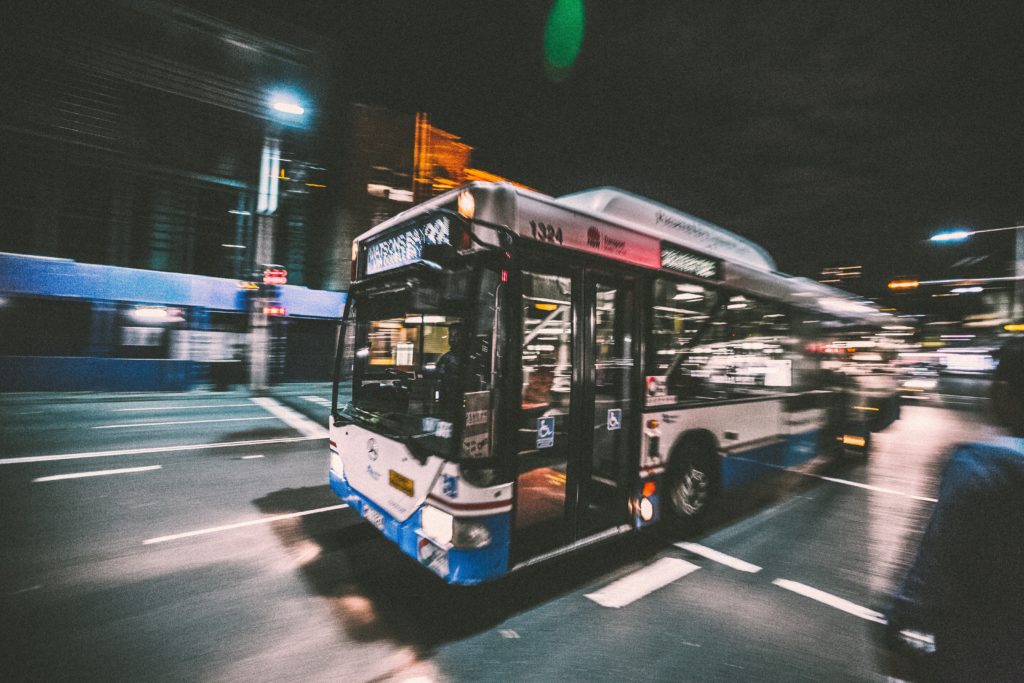
Enhancing Driver Visibility – Removing the Deadly Blind Spot
Every vehicle has blind spots, but transit vehicles are particularly vulnerable to blind spots due to their size and composition. On a transit bus, blind spots not only impair driver visibility but often lead to deadly (and costly) collisions. Improving driver visibility can increase the safety of passengers and pedestrians and should be an integral part of any transit system’s safety program. But what are some solutions available today that help solve the killer blind spot? Let’s examine a few that have been tried to increase driver visibility and prevent common types of collisions.
Defensive Driving Techniques and Policies
Rock and Roll. Bob and Weave. No, these are not examples of the latest dance craze, but real-life strategies bus operators are trained to use to improve their visibility around the bus. These types of defensive driving techniques as well as policies on turning procedures are recommended to prevent pedestrian collisions in the Transit Cooperative Research Program (TCRP) Guidebook for Mitigating Fixed-Route Bus-and-Pedestrian Collisions.
The key behind this approach is to attempt to overcome and compensate for the presence of blind spots. Although mandatory turning procedures, such as no right turns on red lights or continual scanning when entering an intersection, have been reported to reduce the likelihood of a pedestrian accident, they do not materially improve driver visibility or eliminate the blind spots causing collisions, particularly those contributing to lane change crashes. Furthermore, some techniques such as square left turns or bobbing and weaving can take a toll on the operator’s body and increase disability rates.
Operator Training & Public Outreach
Another approach is to train both operators and pedestrians to be especially vigilant of potential bus blind spots and take steps to avoid collisions. Examples of this would be bus safety posters or decals with awareness messaging about staying alert and mindful of bus blind spots. Although this takes steps to reduce the risk of a pedestrian collision, or at least reduce the severity of injuries, the blind spots remain.
Bus Stop Design or Bus Modification
In some cases technology designed to improve safety, such as side mirrors or thick bus A-pillars, can create vehicle blind spots that are particularly dangerous for pedestrians. Use of smaller mirrors, or adjustments to their placement can improve driver visibility. At bus stops, better lighting can improve visibility at night, while increased sidewalk space and traffic control technology can help prevent the likelihood of pedestrian accidents.
Collision Avoidance Technology
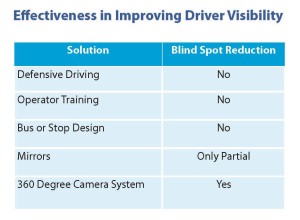 The most common technology used on transit buses to reduce blind spots is mirror technology. This can improve visibility along the left and right sides of the vehicle, but does not completely eliminate side of vehicle blind spots or improve rear views. Traditional back-up or rear-vision camera systems help with the rear view, but rear-backing scenarios and collisions are less common in a typical fixed bus route.
The most common technology used on transit buses to reduce blind spots is mirror technology. This can improve visibility along the left and right sides of the vehicle, but does not completely eliminate side of vehicle blind spots or improve rear views. Traditional back-up or rear-vision camera systems help with the rear view, but rear-backing scenarios and collisions are less common in a typical fixed bus route.
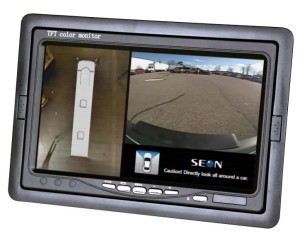 One of the more promising emerging camera technologies to eliminate blind spots, is the around vehicle monitoring system, such as the recently introduced inView 360 product from Seon. With this technology, four cameras are strategically placed around the vehicle to capture an ultra-wide angle view of each side of the vehicle. These four views are blended and stitched together to give drivers a real-time, 360 degree bird’s eye view around the vehicle on a dash-mounted monitor. A split screen also displays a second view that changes depending on operating conditions. For example, when a driver employs the turn signal to change lanes this will change the view displayed on the right side of the monitor from the front view to the left or right side view.
One of the more promising emerging camera technologies to eliminate blind spots, is the around vehicle monitoring system, such as the recently introduced inView 360 product from Seon. With this technology, four cameras are strategically placed around the vehicle to capture an ultra-wide angle view of each side of the vehicle. These four views are blended and stitched together to give drivers a real-time, 360 degree bird’s eye view around the vehicle on a dash-mounted monitor. A split screen also displays a second view that changes depending on operating conditions. For example, when a driver employs the turn signal to change lanes this will change the view displayed on the right side of the monitor from the front view to the left or right side view.
Although data on the impact of this technology for preventing collisions is limited due to its relative infancy, a 2002 study on side view camera-based systems by the Florida Department of Transportation revealed a number of promising conclusions.
Wide-angle side view cameras were able to eliminate 100% of blind zones on the left and right sides, and provided better observation of boarding and late arriving passengers, and better lane change visibility. Camera systems also provided better visibility in dark conditions or inclement weather than mirror solutions. Finally a driver survey showed that a camera-based system provided an image that is simpler and faster to process and that drivers were quick to adapt to. Drivers reported feeling more confident in lane changes and believed it would reduce side crashes.
Although we’ll never eliminate transit bus collisions caused by operator fatigue and distraction, or pedestrian inattention, this new camera technology is so far one of the only ways to eliminate one of the deadliest of contributing factors in collisions – the blind spot.
Practical Tips For Better Video Management
Installing a video surveillance system helps protect against false claims, improve operator safety and reduce overall risk for transit systems, but safety and security departments need to plan ahead to avoid being swamped by requests to deliver video evidence. To reduce strain on resources supporting your video safety program, there are several strategies to ensure success.
Publish a video surveillance policy
The first step in maintaining a manageable workload for staff handling video requests is by creating a comprehensive video management policy. Your policy should cover the ‘5 W’s’ – who, what, when, where, and why video footage should be accessed. Clearly describe the situations when it is appropriate to pull and review video footage as a pro-active measure in reducing the number of frivolous requests for video review. This can save your security team a lot of time and effort in the long run. Detail why video surveillance is being conducted and what will be reviewed, citing the steps you’ve taken to protect the privacy of operators and the general public.
Ensure that you have consulted any union and legal representation to protect the privacy of individuals recorded, and ensure the integrity of video evidence. Assign roles and be specific about who is authorized to maintain versus view versus distribute video and to whom. Dictate exactly where video will be stored and for how long.
Video protection features
A good video surveillance policy will ensure video does not get into the wrong hands and become a viral sensation on YouTube, or a PR nightmare, but there are a few features you should also look for before selecting the right video surveillance system. The first is a locked case for the digital recorder that prevents cables from coming loose and unauthorized access to storage media. Cameras should also be tamper-proof and vandal-resistant. Aside from physical security features on video hardware, playback software should feature proprietary video formats so video cannot be viewed without authorized software.
Password protection can further limit unintentional access to software installed on a shared device. Privacy blurring is critical to protect innocent bystanders.
Lastly, data verification and encryption can ensure that once a video clip is created, the content is not altered.
Minimize video retrieval and handling
The best way to reduce video retrieval and incident investigation time frames is to invest in automatic wireless downloading and video management software. Without it, you risk having requests from insurance companies and law enforcement tying up resources to retrieve hard drives, a time consuming task when buses are parked in multiple yards, or spread across a large geographic area.
Avoid an exhausting search for which bus may have been in the area at the time, and tedious review of hours of irrelevant footage by using video management software to create a zone of interest and display any bus routes that travelled through that area in a given time-frame.
You can click on the route path on a map to set start and end points to schedule video download when buses return to the yard. Or you can have alarmed video trigger automatic downloads for later review.
A word of caution when architecting your wireless network: Video requires a high-bandwidth connection with consistent throughput and connectivity to ensure fast, reliable downloads. Ensure your chosen vendor has Certified Wireless Network Administrators (CWNAcertified) on staff to avoid any unpleasant surprises down the road.
Proactive maintenance
One last tip to ensure video is always there when requested is a pro-active maintenance program. Just like your fleet vehicles, video surveillance systems require regular inspection and maintenance for smooth operation. Video management software can help save time by providing authorized maintenance personnel a cloud-based system health dashboard indicating which surveillance equipment needs attention. See immediately which hard drives have been left unlocked or not replaced, cameras need maintenance, and even GPS units need adjustment. Scheduled, random automated video clip downloads can even help identify cameras not positioned correctly or tampered with.
These are just a few practical tips that, when addressed up-front, can help make managing video easier. Don’t wait until you’re overloaded with requests for video footage. Plan ahead to make better use of technology to free up staff to focus on what they do best – keeping your transit system running safely and efficiently.
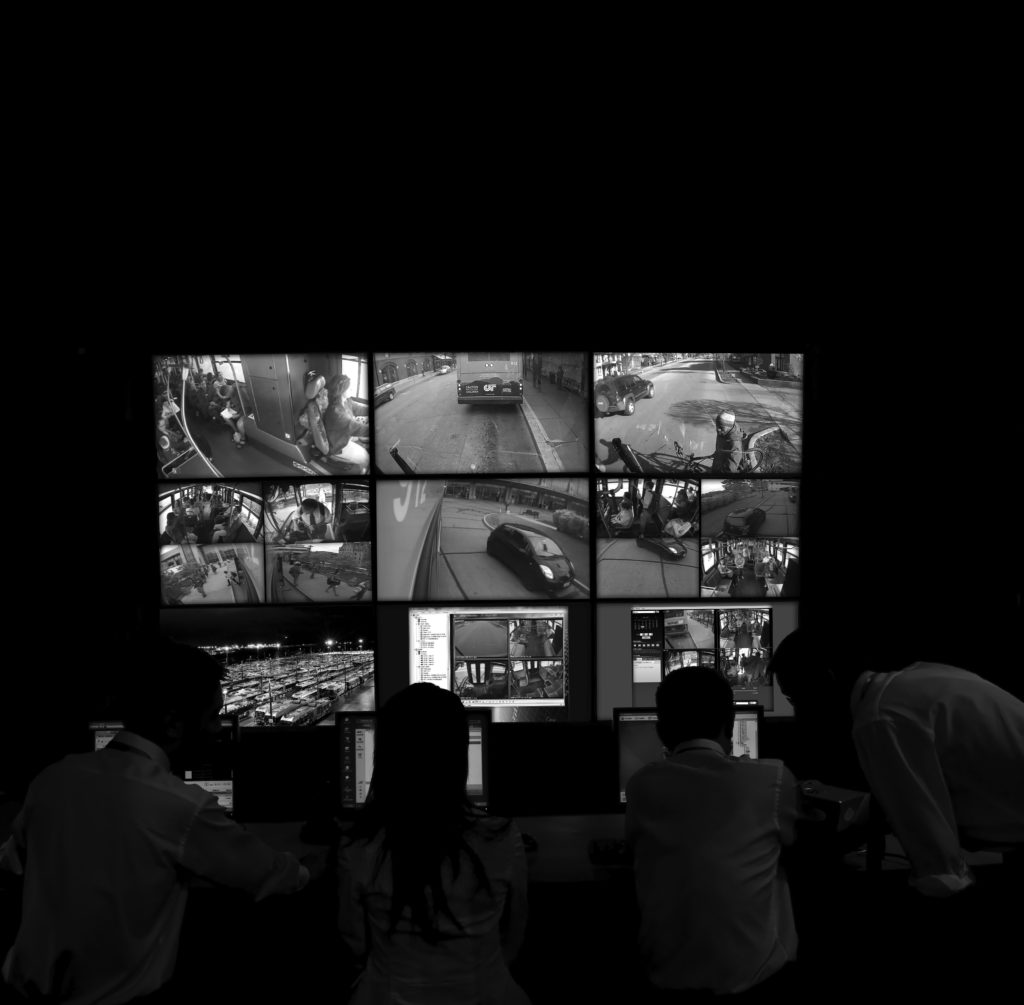
Video Surveillance Footage Review – Best Practices
One of the key pain points when it comes to surveillance footage is the volume of requests for video. Once video has been used to successfully exonerate a driver from a false accusation, or school administrators have used it to solve student discipline issues, these requests can become overwhelming. And most of these issues are time sensitive. Here are six tips to find video faster and investigate reported incidents in record time:
- Get Drivers to Mark Video
One really simple, low-cost solution to avoid having to review hours of irrelevant video footage is to install a panic button in the driver console. When an incident occurs on the bus, drivers can push the button to mark the video for later review. Then once the video is retrieved, viewers can jump to the alarm immediately as it will be marked on the video review pane without scrolling through footage from an entire route or several days.
- Enhance Your View with Vehicle Telemetry
The addition of a GPS receiver to your video system can also speed up your investigation times by giving you additional context to the situation such as vehicle speed, location and directions. Video review software should also incorporate vehicle signals such as stop-arm deployment, turn signals and brakes. These are essential when producing video evidence to prosecute stop-arm violations.
- Download Video Automatically via Wi-Fi
Save time travelling to the bus to retrieve footage, have marked events download automatically as the bus returns to the yard. Make sure your Wi-Fi network is ready to handle video. Work with a reputable mobile video surveillance provider with Certified Wireless Network Professionals (CWNP) on staff to ensure it is qualified to handle video data.
In our recent case study with Frisco Independent School District , the District’s transportation team explained how wireless downloading helped them save time and be more efficient. Doug Becker, Transportation Director at Frisco ISD, says, “We used to have one staff member whose job was to chase videos everywhere. Now this person is helping us run the fleet while there are several people who can access data from different locations if required. We don`t waste time searching for video anymore.”
- Pro-actively Monitor Video System Health
A transportation director never wants to tell a parent or principal that the video didn’t record because they forgot to replace or lock the hard drive, so they need to pro-actively monitor the health of the video system. A video health dashboard like vMax Pulse lets you easily spot maintenance needs and address them immediately.
- Invest in the Right Video Management Platform
Spot checking random clips of video is good for ensuring things like quality of driver-student interaction in special needs transportation, but can be time consuming for a large fleet with hundreds of drivers. Video management software can be set up to automatically trigger a video download based on driver-initiated panic alarms, travel outside of a specific route, or dangerous driving behavior such as a sharp turn, speeding, or hard braking. When integrated with a live GPS tracking service, the system will allow a fleet manager to see these alerts in real-time.
When a parent reports a bus was speeding, or an accident occurs, you can quickly locate the right bus and the right video by date, time or even GPS Location and click on the map to schedule a download when the bus returns to the yard.
Finally this type of software can even facilitate random spot checking by allowing you to schedule short video clips to download for review once a day, week or month.
- More Cameras = Better View & Faster Incident Resolution
Even though high-definition cameras are increasing in popularity, there is no substitute for more cameras. It’s hard to get a complete picture of every seat in the bus with less than four cameras. A recent report released from the NTSB that chronicles the Port St. Lucie school bus crash involving a student fatality demonstrates how essential camera placement is in accident reconstruction.







